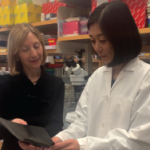Several approaches to repair have been and continue to be explored. Early on, Dr. Redlich, who is now associate professor at the Division of Rheumatology of the Medical University of Vienna, also showed, in another animal model, that combining an anti-TNF agent with administration of teriparatide, a parathyroid hormone used to treat bone loss in osteoporosis, worked to arrest erosion and induce bone repair.9 Dr. Redlich also sees promise in deciphering T cell trafficking to the joints. “Targeting different cell populations selectively in the joint should be our scope for the future,” he says.

Dr. Gravallese, Dr. Schett and others have also shown that inflammation plays a role in inhibiting the osteoblast differentiation and function and that the Wnt/beta-catenin pathway in osteoblasts may be a potential target for inducing bone formation. Based on his group’s preclinical studies, Dr. Schett believes that antibodies against sclerostin may allow repair of existing damage. This line of investigation is now leading these groups onto the next horizon: understanding the mechanisms by which excess bone is made in the entheses, leading to the rigidity and morbidity seen in spondyloarthropathy.
Role of Inflammation in OA?
Although osteoarthritis has generally been perceived as a degenerative disease, “We are beginning to understand that there is an inflammatory component to osteoarthritis,” notes Dr. Aliprantis. “It is more likely to be that some of the degradation products activate macrophages or other innate immune cells to make inflammatory cytokines, which in turn causes more cartilage damage.”

The interplay between the immune system and cartilage is not well understood, he says, but evidence of upregulation of inflammatory pathways was found by his group in the joint fluid of patients with osteoarthritis, which suggests that there is activation of inflammation.10
The role of inflammation in osteoarthritis is one line of investigation at the UCSF/Stanford Arthritis Center of Excellence, funded in part by the Great West Region of the Arthritis Foundation. Dr. Nakamura is the director of the UCSF component of that center, and William Robinson, MD, who has conducted animal studies in this regard, serves as director for the Stanford component. In addition, Mark Genovese, MD, is currently conducting a human trial of OA with hydroxychloroquine and atorvastatin.
Future Horizons
Many challenges remain in osteoimmunology, and worldwide the research activity has increased exponentially. Basic science research by Ellen Gravallese, Georg Schett, Kurt Redlich, Hiroshi Takayanagi, Steven Goldring, Mary Nakamura, Tony Aliprantis and others continues to push the field forward.
